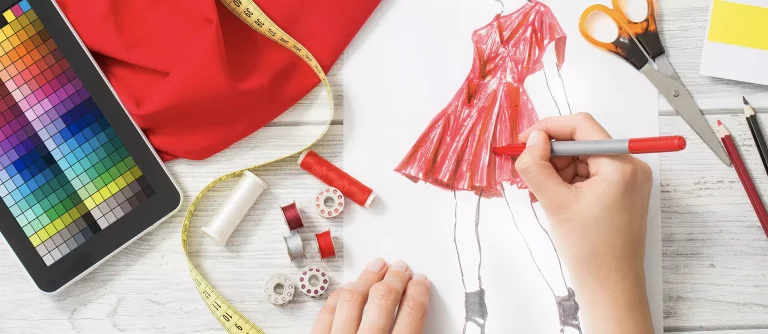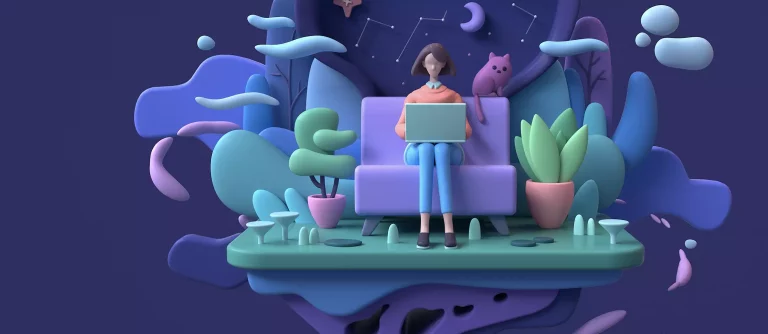How To Become a Graphic Designer
Choosing the perfect career path for you can be a daunting task. If you have a passion for art and anything creative, the ideal job would be one that lets you incorporate your creative side, like graphic design.
This artistic field has evolved immensely over the few decades, and there are growing demands for graphic designers in certain job circles.
Is graphic design right for you? If so, how do you break into the field? We have the answers to all of your questions about graphic designers.
What is a Graphic Designer?
The title “graphic designer” can cover numerous professional endeavors and positions, from a visual journalist to a creative director. Even though there are several types of graphic design jobs, the goal is the same: to effectively communicate ideas through the creative use of graphics, words, and photos.
In other words, graphic designers are the genius behind beautifully crafted ads, campaigns, websites, and logos. They manipulate various types of media to inspire an audience visually.
Not only do they work with print design, fonts, photography, color, and animation, but they also join forces with fine artists, photographers, and animators to create the most compelling design.
A graphic designer may work on dozens of diverse projects throughout their career, including various subdivisions of graphic design, such as the following:
- Art Director
- Interface Designer
- Content Developer
- Web Designer
- Visual Image Developer
- Creative Director
- Brand Identity Developer
What Does a Typical Workday for a Graphic Designer Look Like?
A typical day as a graphic designer varies depending on where you work. You can work as a freelancer, an in-house graphic designer, or an agency graphic designer.
Freelance graphic designers can make their own schedule, choose projects, and enjoy the flexibility of working from home. In-house graphic designers work for one particular company, have a regular paycheck, and treasure the companionship of working with numerous coworkers.
An agency designer is a combination of freelance and in-house designers. They get varied projects from numerous clients but also have the chance to work in a team setting.
While the setting and hours may vary among designers, their daily tasks are similar.
For each project, a graphic designer will start by accepting (or applying for) a client’s brief. They will then create a timeline based on the requirements and establish an overall cost for the project. If a designer is working for an agency or company, the company may set the price instead.
Once the designer has a project – or several projects – they will fill their days with developing ideas and concepts to present to the client, creating multiple drafts and edits, and finetuning the final product to satisfy the customer.
While each designer has their own artistic process, most spend hours each day online. They may still integrate original illustration and photography, but the industry, in general, has moved almost exclusively to a digital format.
Will I Like Being a Graphic Designer?
While being a graphic designer may sound great on paper, it is not ideal for everyone. Like any other job, being a designer takes a certain skill set; being creative is not enough!
Consider all of the skills and characteristics of a successful graphic designer to see if you are the perfect fit.
Characteristics and Skills of a Good Graphic Designer
Graphic design, like other jobs in the art world, requires a lot of patience and dedication.
When you try to satisfy a customer and create something innovative, you need to be open to constructive criticism from your client. Even if that means ten drafts of one logo, patience and drive will keep you motivated through the creative process.
Another crucial trait of being a successful graphic designer is superior communication skills. You aren’t just creating something that you like, but what your client or company needs. Timely responses, openness to criticism, and general customer services skills are vital to obtaining and retaining a steady clientele.
Finally, you need stellar time management. As a fine artist, you can create how, when, and where the inspiration strikes. However, a graphic designer has to work on a schedule to appease the client and take on more jobs. You need to understand your creative process, set appropriate deadlines, and follow through with the schedule you – or your agency – set for the project.
Why You Might Not Like Being a Graphic Designer
There are three main reasons why someone may not enjoy being a graphic designer.
First, art is subjective. What you think is fantastic may not be what your client wants. You may not get to create what you want on every project because your end goal is providing content that fits the company and brand. This part of graphic design may frustrate many artists by hindering their creativity in some situations.
Just like time management is a necessary quality of successful graphic designers, it could discourage some potential designers. If you find yourself struggling to fit your creativity into a schedule, graphic design may not be the right fit.
The last potential deterrent is the unsteady pay that freelance designers may receive. If you work as an in-house designer, this may not be a problem, but many freelancers may have to compete with hundreds of other prominent designers to snag a project. Even then, many people and companies try to underpay their designers.
Typical Schooling for a Successful Graphic Designer
To have a successful career, you will need to have at least a Bachelor’s degree in an appropriate field. While a graphic design degree is ideal, you can also work in the industry with a web design, animation, or art degree.
A Bachelor’s of Arts or Fine Arts degree usually takes four years to complete, and you can consider pursuing a Master’s in the same field after graduation.
In your undergraduate studies, you will likely take courses covering a wide range of topics. Get ready for web graphics, art, animation, photography, principles of design and color, and multimedia.
Apart from the degree, you will need to have numerous skills and certifications since graphic design combines many artistic components. Impressive drawing skills and high proficiency in multiple design platforms is a necessity.
Consider pursuing certifications in the following areas:
- Adobe Photoshop
- Autodesk 3ds Max
- Adobe Instructor
- Adobe InDesign
- Adobe Illustrator
Best Graphic Design Colleges
Since graphic design has become a popular and evolving career choice, numerous colleges and universities offer design degrees. You can opt to get your Bachelor’s at your local state college, or you could look at some of the most renowned schools.
Since graphic design is a mostly digital profession, the major is a prime option for those pursuing a completely online degree. If you would like to study graphic design in the comfort of your own home or while working a full or part-time job, consider one of the online college choices below.
Whether you pick an online or in-person school, a degree from one of the following colleges and universities will make you stand out from the competition for jobs after you graduate.
1. Parsons School of Design – In-Person Studying
As one of the most well-known art schools in the country, Parsons School of Design tops our best colleges list.
Located in Lower Manhattan of New York City, students not only have access to quality professors and fantastic classes, but they are also in the heart of the artistic center of the country. With museums and famous designers just around the corner, the location is a huge advantage.
Since this is a prestigious school, the acceptance rate, at 35%, is lower than some other top schools. Plus, the tuition is on the higher end, reaching over $50,000 per year.
If you are looking for a prestigious school that hires famous designers as professors, Parsons is a fantastic option.
2. ArtCenter College of Design – In-Person Studying
Even though the ArtCenter College of Design doesn’t have Parsons’ name recognition, it consistently ranks extremely high on numerous best colleges lists.
The prestigious staff at the ArtCenter focuses on all media types, developing a well-balanced portfolio and skill set. From 3D motion graphics to packaging, students will gain experience in numerous graphic design fields.
The acceptance rate is much higher than Parsons, coming in at 70%, but the price is only slightly lower. With each semester costing almost $23,000, the complete year comes to a total of nearly $46,000.
The ArtCenter offers quality instruction in the sunny Californian climate. If you would like top-notch professors and experience without some of the stress of a competitive acceptance rate, try the ArtCenter College of Design.
3. Carnegie Mellon University – In-Person Studying
The other top two schools have “design” in their name, but not Carnegie Mellon University. While this university started as a technological school focusing more on computer science than anything else, it has branched out over the years to offer degrees in numerous fields, including graphic design.
Carnegie Mellon has made an incredible name for itself by providing a well-rounded education. Graphic design is the merging of multiple areas of study, from art to technology.
At Carnegie Mellon, you can choose courses in various schools of study to support your design major. Plus, by studying graphic design at a prestigious technological school, you can gain expertise in the multiple software platforms designers use.
Carnegie Mellon University is one of the most prestigious schools in the country for any career, so they have an acceptance rate of 17% and a tuition fee of almost $60,000 per year.
If you want a prestigious school that will give you the well-rounded skills you need, Carnegie Mellon will be worth the price.
4. Liberty University – Online Studying
Liberty University is a popular online school. They focus on preparing all of their students for the workforce waiting for them after graduation. From a mandatory internship in the final year to building a portfolio, Liberty University ensures the students are well-equipped post-graduation.
They accept slightly over half (55.5%) of all the students who apply, and they charge the incredibly low cost of about $23,00 a year.
If you’re nervous about studying online, Liberty University is a very reputable school that puts its students first.
5. Savannah College of Art and Design – Online Studying
The Savannah College of Art and Design has received numerous awards for excellent online instruction. Since the school has provided digital education for about 20 years, they know how to provide superior education even through a screen.
They have an acceptance rate of about 70%, and the tuition is fairly affordable at almost $38,000 per year.
The Savannah College of Art and Design is a great choice for anyone looking for expertise, an experienced staff, and plenty of technological preparation.
6. California Baptist University – Online Studying
The graphic design degree from California Baptist University is a shorter and cheaper graphic design program. You will only spend about 16 months, or two school years, studying online. The total cost will total just under $30,000, or $15,000 per year, and the acceptance rate reaches almost 80%.
Just because the course is shorter and more affordable doesn’t mean it is not a wonderful education. Quite to the contrary, the major includes classes in typography, web design, and photography, among other key subjects.
If you are looking for a less intensive schooling option to complete while working, California Baptist University could be a fantastic option for you.
Can I Skip College and Teach Myself How to Be a Graphic Designer without a degree?
Yes, you can become a graphic designer without going to college. While some employers may immediately write you off for not having a graphic design degree, don’t let that deter you from taking a non-traditional path to becoming a graphic designer.
Start your journey by learning to draw and understand design theory. These first two steps will give you the foundation you need for success. From there, practice using as many software platforms as possible. It will take time, but this step is crucial to compete with professional designers.
Finally, once you have a handle on the design world, pick your specialty, and build your portfolio. Get your name out there, and start applying for jobs. It may be slow initially, but with just a couple of jobs initially, you can get a foothold into the industry.
Three Non-Traditional Paths to Become a Graphic Designer
1. YouTube and Paid Tutorials
Video lessons are almost as good as in-class instruction. With tons of resources at your fingertips, why not take advantage of them? Look for free lessons on YouTube or pay for a few video tutorials from the professionals to give you some crucial tips.
2. Short Online Programs
Numerous websites offer free or low-cost classes covering a wide variety of topics. One great example is Alison. While the courses are short, they can provide you with a wealth of information to further your independent study. Plus, you can get a diploma to prove you complete the course.
3. Graphic Design Certificates
Some graphic designers get certificates in multiple areas to show their varied skills, so this is a great step for pursuing a graphic design career. Look for certificates in graphic design, Photoshop, Illustrator, and web design from places like Coursera.
While a certificate won’t carry as much weight as a degree, it does show dedication and skill.
Which Software Programs do Graphic Designers Use?
Graphic designers use various software programs, and new ones are constantly surfacing with new tools and techniques. Here are some of the best paid and free programs available to designers:
- Adobe Photoshop (for Mac and Windows) – Paid
Photoshop is the most well-known platform for a good reason. You can edit every detail of a photograph, make 3D work, and paint on your canvas.
- Adobe Illustrator (for Mac and Windows) – Paid
Where Photoshop focuses on image editing, Illustrator handles vector design so you can produce iconic posters and icons.
- CorelDRAW Graphics Suite 2019 (for Mac and Windows) – Paid
This platform is ideal for beautiful vector illustrations. You can use tools like LiveSketch, PhotoPaint, and Corel Font Manager.
- Xara Designer Pro X (Windows) – Paid
Xara offers a little bit of everything. You can work on illustration, desktop publishing, and illustration with this platform.
- Sketch (for Mac only) – Paid
Most graphic designers use Sketch and its numerous plugins to create stylish apps and websites.
- GIMP (for Mac and Window) – Free
GIMP is comparable to Photoshop and lets you manipulate and retouch photographs.
- Vectr (for Mac and Windows) – Free
With Vectr, you can easily design posters, business cards, and logos with vector graphics.
- Canva (for web browser and phones) – Free
Canva is the ultimate package for amateur graphic designers, with plenty of templates and images.
What Are the Best Blogs and Influencer Accounts to Follow?
The graphic design world is huge, with hundreds of thousands of professionals across the country – and much more worldwide. One of the best ways to get involved in the field and learn from the experts is to follow successful designers.
Start by reading some popular design blogs, such as Envato Tuts +, The Design Blog, Telepathy, and Creative Bloq. Each page has its own focus. For example, The Design Blog is great for inspiration, while Envato Tuts + is full of fantastic software tutorials.
Again, there are thousands of prominent graphic designers you can follow for inspiration. To get you started, you can follow David Airey (logo master), UnderConsideration (graphic design firm), and Mister Doodle (typography).
Five Ways to Break into the Graphic Design Industry
Breaking into any artistic field as an amateur can be stressful. You will be competing with experts in the field while building your resume and making a name for yourself.
The positive part of graphic design is that there is a wide diversity of jobs available, and some continue to grow in demand as time passes.
Whether you’re a complete beginner or an experienced artist taking a new direction into the graphic design field, you can get plenty of work in no time with the following five tips.
Get Online
Before applying for a single job, the first step is to create your own website. Since you’ll be applying for most of your jobs online, you must have your portfolio on an easily accessible site.
Plus, since graphic designers work mainly online, and many will even do web design, your digital portfolio needs to be flawless. Take the time to showcase your skills in website design and layout so you can impress potential clients before they even open the examples in your portfolio.
To get an idea of what a fantastic online portfolio should look like, check out other designers’ websites. Look for accessibility, clarity, and, of course, the design.
Start building your digital portfolio by choosing a website builder. One of the most well-known platforms is WordPress. While this is a fantastic option, it is best for designers who want to include a blog portion with their portfolio.
If you are looking only to showcase your work, consider sites like Squarespace or Duda. Both of these platforms are comparable in price, have unlimited storage, and incredible design options.
For quality design options and a free plan option, try Weebly.
Get Social
Making your online portfolio is just the first half of getting online; the next step is making your presence known on social media.
Post your work, prices, and deals on several of the most popular social media platforms so people all over the world can see your work. Plus, once you have a following, it is crucial to interact with your followers and maintain constant communication.
Some of the most obvious choices are Instagram and LinkedIn. However, not everyone knows how to use these sources effectively.
While Instagram is a photo-sharing platform, it is best not to post photos of your work because that’s not necessarily what your followers want to see. Engage them instead with pictures of your creative process or things that inspire you. The key is interaction with your community.
LinkedIn is a more professional platform, so focus on keeping your information updated and accurate. Add any new jobs and projects to your profile to continue boosting your profile. Also, make sure to add a link to your online portfolio.
Some lesser-known platforms (but ones that are prominent in the design world) are Dribbble and Behance. Dribbble is an exclusive platform that only lets certain designers publish photos of their work. Even if they don’t accept your visual work right away, you can still be a part of the platform to learn from other designers.
Behance is another must-have for any graphic designer. Create a stellar portfolio to express your artistic point of view and showcase your work.
These sites are just a few of the top social media platforms that designers use. While it may be difficult to manage so many profiles, it is vital to get your name and work out there.
Become an Apprentice
While taking an apprenticeship or internship right after college may not be the ideal option financially, it can pay off in the long run.
There is no better way to learn how to be a graphic designer than to shadow someone already successful in the field. You can study as many classes as you wish, but the real-world experience will give a taste of the job and responsibilities that no school could ever teach.
Besides getting a taste of the daily grind for a graphic designer, you will meet potential clients, build your portfolio, and get an incredible experience to add to your resume. Some companies may be hesitant about hiring people fresh out of college. As such, an apprenticeship can give you an edge over other applicants.
Continue Learning
Because graphic design uses so much software, one of the best things you can do to further your career is to learn the trade’s latest tricks. Never settle into a groove because the technological and artistic advances will take you by surprise.
You can always learn something new, so take the time each week to watch YouTube or paid tutorials and practice new techniques.
You can also branch out into separate graphic design categories and master new skills to include on your resume. If you are working on logo design, study web design in your spare time to have even more job opportunities. Plus, having extra skills could land you a more inclusive job encompassing all areas of graphic design.
Keep Grinding
When breaking into an artistic field, whether acting, fine art, or even music, failure and rejection are part of the game. Art is subjective, and not every client will like your work.
The trick is to keep grinding. Put your head down, and don’t let the rejection discourage you. Instead, let any early failures be a learning experience for you.
Whether you had a setback with time management, communication, or design elements, take it in stride and use it to become a better graphic designer.
FAQ
Choosing a career path is a massive decision, one you should not take lightly. Before you make your final choice, look at these questions that many aspiring graphic designers have asked.
Hopefully, the answers will guide you towards your perfect career.
How Much Money do Graphic Designers Typically Make?
The salary for graphic designers can vary drastically from under $34k a year to well over $64k. If you’re just starting as a graphic designer or pursuing a freelancing career, you can expect a lower yearly salary, especially at the beginning of your journey.
As you gain experience, loyal customers, and a fantastic portfolio, you can charge more for your work.
On average, though, most graphic designers earn about $46k per year.
What Do You Study to Be a Graphic Designer?
The best course of study would be to get your Bachelor’s in graphic design, which takes about four years. However, if you have a major in another artistic field, like animation or web design, you can easily use that to pursue a graphic design career.
If you have a different art degree, a great option would be to get a graphic design certificate to showcase your skills and versatility.
To prepare for a graphic design degree, you can start by electing to take as many art courses as possible in high school. If your school offers them, take art and design courses each year. You can also look at nearby art studios or schools for more advanced classes if your high school only has limited choices.
Is Graphic Design a Good Career Choice?
If you love being creative, have plenty of passion for design, and are willing to work for various clients, graphic design may be a fantastic career choice for you.
However, keep in mind that it is a competitive, ever-changing field that requires you to always be on your toes, adapting to new technological advances. The salary can also be great if you are willing to put in the time and effort to acquire and retain clients.
The work may not always be what you want to do, but it can be an incredibly rewarding career if you have the patience and drive to push through some of the more humdrum projects.
Are There a Lot of Job Openings for Graphic Designers?
Graphic design covers numerous professions, so the number of job openings depends on the specialty.
For example, experts estimate a 24 to 26% increase in job opportunities for graphic designers working with computers and online design. Additionally, social media design, video editing, and mobile advertising fields are becoming increasingly popular.
While the digital design formats are growing in popularity, other more traditional graphic design areas are experiencing a decline in job openings. There has been a significant decrease in job opportunities in illustration and book design as digital advertising is taking over the field.
If you’re interested in graphic design, try to develop skills in all areas to multiply your job opportunities. For example, if illustrating is your passion, ensure you can also create products in web or social media design if there are limited illustrating jobs.
What’s the Best Website to Find Graphic Design Job Listings?
There are several popular websites to find graphic design jobs.
Two of the most popular sites, 99Designs and Designhill, focus on competitions set by the client. While these can be a fantastic way to build your portfolio, it can be frustrating competing with dozens or hundreds of other designers for one project.
If you would like to look directly for job listings and apply with your resume and portfolio, a website like Upwork may be a better choice. While the site is for freelancers of all types, there are plenty of graphic design listings that you apply for regularly.
What Are Some Big Companies that Hire Graphic Designers?
All types of companies hire graphic designers. Visually beautiful campaigns and websites sell products, so all types of organizations need stellar graphic designers.
Some companies hire graphic designers directly, while others go to a design agency or organization.
If you want to be a part of a design company that caters to huge name brands, consider companies like Pentagram (works with Starbucks, Warner Brothers, and Windows), Landor (creates content for Apple, Kellogg’s, and Volkswagen), and Wolf Olins (works with eBay, Microsoft, and Target).
Of course, some large companies look for freelancing graphic designers on popular job-listing websites. A few of the most noteworthy names include Google, Walt Disney Company, Nike, and Amazon.







